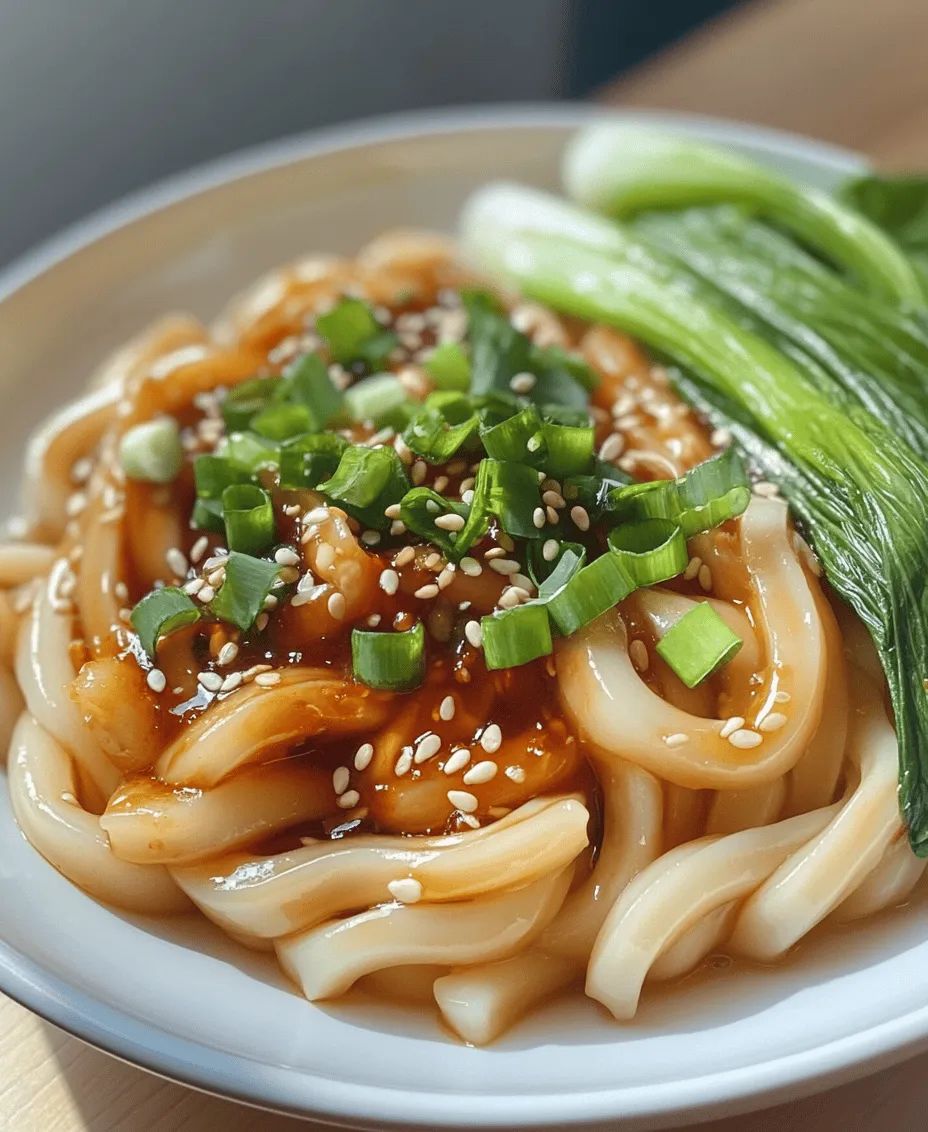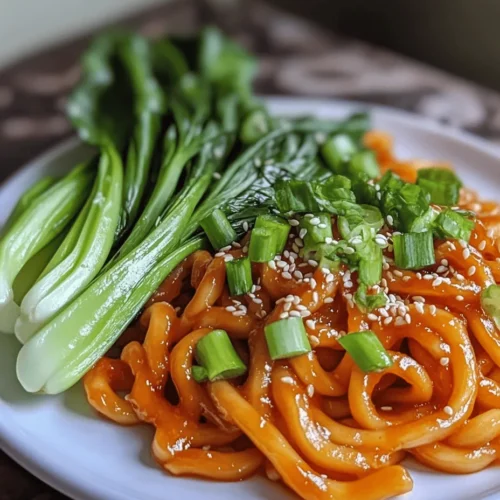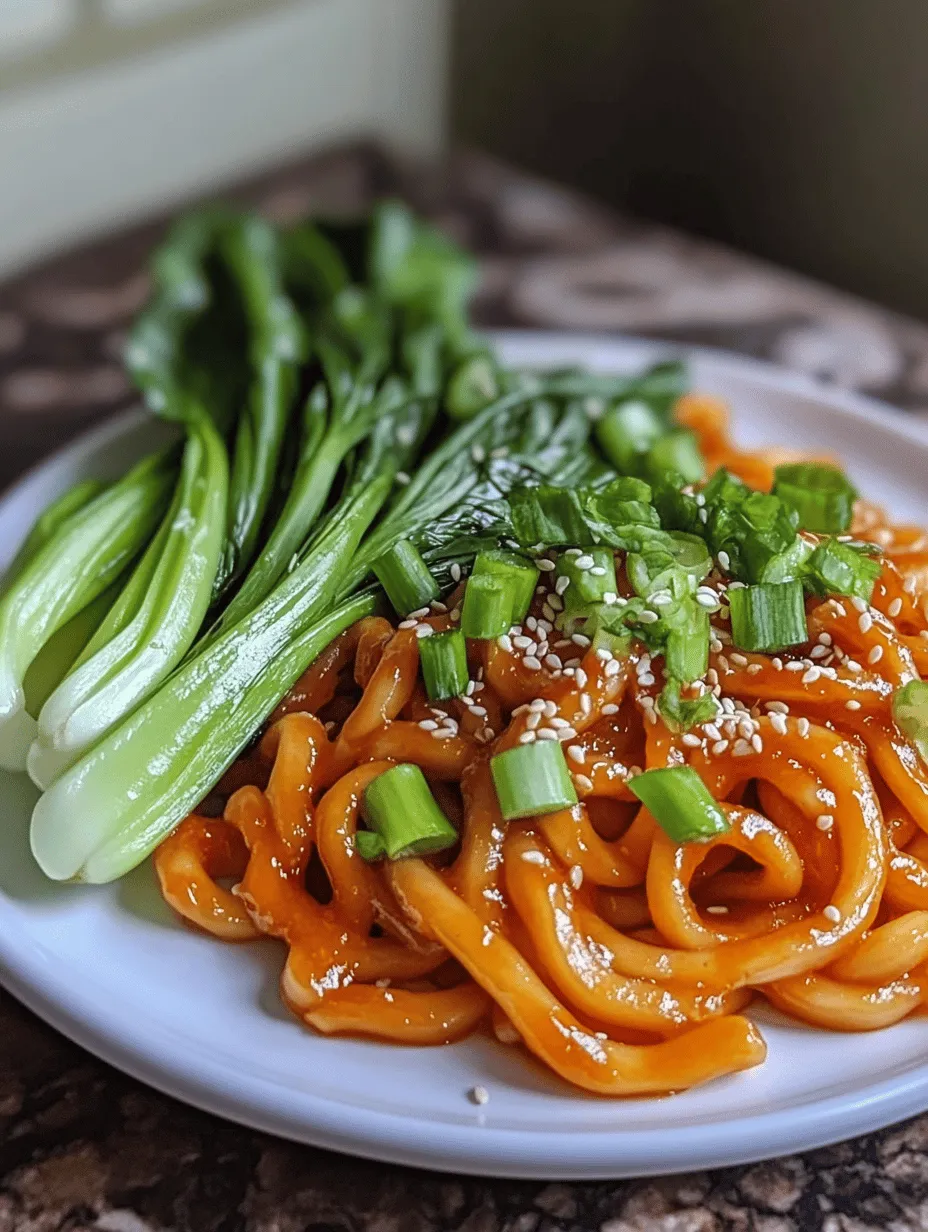Introduction
Udon noodles have captured the hearts and palates of food lovers around the globe, celebrated for their chewy texture and versatility. Originating from Japan, these thick wheat noodles are a staple in various Asian cuisines and have found their way into countless dishes, from hearty broths to stir-fries. They are not only delicious but also adaptable, making them a perfect choice for busy weeknight dinners or an impressive meal when entertaining guests.
In today’s fast-paced world, quick and easy meals are a necessity for many home cooks. With the hustle and bustle of daily life, finding time to prepare a nutritious and satisfying meal can be a challenge. This is where the 10-minute chili oil udon noodles come into play. This recipe combines the robust flavors of chili oil, soy sauce, and fresh ingredients, all while requiring minimal time and effort. The result is a dish that is not only quick to prepare but also bursting with flavor, perfect for those who appreciate the art of cooking without spending hours in the kitchen.
Understanding Udon Noodles
Udon noodles are a type of thick wheat noodle that has its roots deeply embedded in Japanese culture. Traditionally served in a variety of dishes, udon can be enjoyed hot or cold, making them incredibly versatile. The noodles are characterized by their chewy texture, which comes from the high gluten content of the wheat used in their production. This unique texture allows them to hold sauces well, making them a popular choice in stir-fried dishes and soups.
Nutritional Benefits of Udon Noodles
In addition to their culinary appeal, udon noodles also offer nutritional benefits. They are typically low in fat and a good source of carbohydrates, providing a quick energy boost. Udon noodles are made from wheat flour, water, and salt, making them a simple yet wholesome option for a meal. Depending on the brand and preparation method, some udon noodles may also contain added nutrients, such as B vitamins and iron.
While udon noodles are delicious on their own, they can be enhanced with various toppings and ingredients to elevate their nutritional profile. Adding vegetables, proteins, and healthy fats can transform a simple bowl of udon into a balanced meal that meets your dietary needs.
Different Types of Udon Noodles Available in the Market
When shopping for udon noodles, you may encounter several varieties. Fresh udon noodles, often found in the refrigerated section of Asian grocery stores, are ideal for quick cooking and yield the best texture. Dried udon noodles are also widely available and can be stored for longer periods, making them a convenient pantry staple. Instant udon noodles, packaged with flavoring packets, are another option, although they may not offer the same depth of flavor and texture as their fresh or dried counterparts.
Regardless of the type you choose, the key to a successful udon noodle dish is to prepare them according to the package instructions, ensuring they maintain their signature chewiness.
The Flavorful Components of Chili Oil Udon Noodles
The 10-minute chili oil udon noodles are not just about the noodles themselves; they are a celebration of flavor. Each ingredient plays a crucial role in creating a delicious and satisfying dish. Let’s break down the key components that make this recipe shine:
Chili Oil: Types, Flavor Profile, and Heat Level
Chili oil is the star ingredient in this recipe, providing a vibrant kick of heat and depth of flavor. There are various types of chili oil, ranging from mild to fiery hot, so you can choose one that suits your taste preferences. Typically made from oil infused with crushed red pepper flakes, garlic, and sometimes other spices, chili oil is a versatile condiment that can elevate any dish.
When selecting chili oil for your udon noodles, consider the flavor profile you want to achieve. Some chili oils are blended with additional ingredients like sesame seeds or Szechuan peppercorns, adding layers of complexity to the dish. If you prefer a milder flavor, look for chili oils labeled as “mild” or “medium.” For those who enjoy a stronger heat, opt for a hot chili oil that packs a punch.
Soy Sauce: Importance in Asian Cooking, Types, and Substitutes
Soy sauce is another essential ingredient in this dish, providing umami richness and depth to the udon noodles. As a cornerstone of Asian cooking, soy sauce comes in various types, including light, dark, and tamari (a gluten-free option). Light soy sauce is typically saltier and used for seasoning, while dark soy sauce adds color and a slightly sweet flavor.
If you’re looking for substitutes, consider using coconut aminos for a soy-free alternative or liquid aminos, which offer a similar flavor profile with less sodium. Regardless of the type or substitute you choose, soy sauce adds a savory element that balances the heat from the chili oil.
Sesame Oil: Flavor Enhancement and Health Benefits
Sesame oil is a flavorful oil extracted from sesame seeds, and it plays a vital role in Asian cuisine. In the 10-minute chili oil udon noodles, sesame oil enhances the overall flavor profile while providing health benefits. Rich in antioxidants and healthy fats, sesame oil is known to support heart health and may have anti-inflammatory properties.
In this recipe, a drizzle of sesame oil adds a nutty aroma and richness that complements the other ingredients beautifully. Be sure to use toasted sesame oil for a more robust flavor, as it imparts a distinct taste that elevates the dish.
Garlic and Ginger: Their Roles in Enhancing Flavor and Health Properties
Garlic and ginger are essential aromatics in many Asian dishes, including our chili oil udon noodles. Both ingredients contribute to the dish’s flavor while offering numerous health benefits. Garlic is known for its anti-inflammatory and immune-boosting properties, while ginger is celebrated for its digestive benefits and ability to reduce nausea.
In this recipe, minced garlic and ginger are sautéed to release their essential oils, infusing the dish with warmth and depth. Together, they create a fragrant base that enhances the overall taste of the udon noodles.
Sugar: Balancing Flavors in Savory Dishes
While it may seem unusual to add sugar to a savory dish, a small amount of sugar can balance the heat of the chili oil and the saltiness of the soy sauce. In the 10-minute chili oil udon noodles, sugar helps to round out the flavors, creating a harmonious blend that tantalizes the taste buds. You can use granulated sugar, brown sugar, or even honey as a sweetener, depending on your preference.
Optional Ingredients: Bok Choy or Spinach, Their Nutritional Benefits and Usage in the Recipe
To enhance the nutritional profile of your chili oil udon noodles, consider adding greens like bok choy or spinach. Both options are packed with vitamins and minerals, providing a boost of nutrients to your meal. Bok choy, a type of Chinese cabbage, is rich in vitamins A, C, and K, while spinach is an excellent source of iron and folate.
Adding these greens not only increases the health benefits of the dish but also contributes a fresh, vibrant color. You can quickly blanch the bok choy or spinach in boiling water for a minute or two before mixing them with the udon noodles, or simply toss them into the pan during the last minute of cooking for a wilted effect.
Step-by-Step Preparation Guide
Now that we’ve explored the delightful ingredients of the 10-minute chili oil udon noodles, let’s dive into the step-by-step preparation guide that will help you create this delicious dish in no time.
1. Gather Your Ingredients: Start by assembling all the necessary ingredients. You will need fresh or dried udon noodles, chili oil, soy sauce, sesame oil, garlic, ginger, sugar, and any optional greens like bok choy or spinach.
2. Cook the Udon Noodles: If using dried udon noodles, cook them according to the package instructions. Fresh udon noodles typically require just a few minutes in boiling water. Once cooked, drain the noodles and set them aside.
3. Prepare the Aromatics: While the noodles are cooking, mince the garlic and ginger. The aromatic flavors will be the foundation of your dish, so cut them finely to ensure they blend well with the other ingredients.
4. Heat the Oil: In a large pan or skillet, heat a tablespoon of sesame oil over medium heat. This will be the base for sautéing the garlic and ginger.
5. Sauté the Garlic and Ginger: Add the minced garlic and ginger to the hot oil, stirring frequently for about 30 seconds. Be careful not to let them burn, as this can impart a bitter flavor.
6. Combine with Chili Oil: Once the garlic and ginger are fragrant, add the desired amount of chili oil to the pan. The heat level is customizable, so adjust it to your preference. Stir the mixture to combine the flavors.
7. Incorporate the Cooked Udon Noodles: Gently add the cooked udon noodles to the pan, tossing to coat them evenly with the chili oil mixture. Be sure to stir carefully to prevent the noodles from breaking.
8. Season with Soy Sauce and Sugar: Drizzle in the soy sauce and add a pinch of sugar. Toss everything together, allowing the noodles to absorb the flavors. Adjust the seasoning to taste, adding more soy sauce or chili oil if desired.
9. Add Optional Greens: If you’re including bok choy or spinach, add them to the pan and toss everything together until the greens are wilted and heated through.
10. Serve and Enjoy: Once everything is combined and heated, transfer the chili oil udon noodles to serving bowls. Feel free to garnish with chopped green onions or sesame seeds for an extra touch.
This 10-minute chili oil udon noodles recipe is perfect for busy weeknights or whenever you’re craving a quick, flavorful meal. The combination of chewy udon noodles, aromatic spices, and vibrant flavors will undoubtedly satisfy your taste buds, making it a go-to dish in your culinary repertoire. Stay tuned for more tips and variations to enhance this delightful recipe!

Preparing the Udon Noodles: Tips for Achieving the Perfect Texture
To create the ideal base for your 10-Minute Chili Oil Udon Noodles, the preparation of the udon noodles is paramount. Udon noodles, made from wheat flour, are known for their chewy and thick texture, which can elevate your dish to a new level. Here are some essential tips to ensure your udon noodles are perfectly cooked:
1. Choose Quality Udon: Whether you opt for fresh or dried udon noodles, selecting a high-quality product can significantly affect the final dish. Fresh udon noodles are typically softer and more pliable, while dried noodles offer a satisfying chew.
2. Boiling Water: Always start with a large pot of boiling water. A generous amount of water prevents the noodles from sticking together and ensures even cooking. Once the water reaches a rolling boil, add the udon noodles.
3. Cooking Time: Follow the package instructions for cooking time. Fresh udon usually takes about 2-3 minutes, while dried noodles may take 5-8 minutes. It’s crucial not to overcook them, as they can become mushy. Taste a noodle a minute before the suggested time to check for doneness.
4. Rinse in Cold Water: After cooking, drain the noodles and rinse them under cold running water. This process halts the cooking and removes excess starch, preventing the noodles from clumping together. Drain well before moving onto the next step.
5. Toss with Oil: To prevent sticking, toss the cooled noodles with a small amount of sesame oil or vegetable oil. This step not only helps maintain their texture but also adds a subtle flavor.
Crafting the Sauce: Techniques for Maximizing Flavor
The sauce is where the magic happens in this recipe, and mastering its preparation is key to achieving that bold, irresistible flavor profile. Here are some techniques to elevate your chili oil sauce:
1. Using Quality Ingredients: Start with high-quality chili oil, as it forms the backbone of your sauce. Look for chili oils made from high-quality oils infused with spices. If you prefer, you can make your own by heating oil with dried chili flakes.
2. Balancing Flavors: Combine the chili oil with soy sauce, which adds umami depth, and rice vinegar for a touch of acidity. This balance of flavors creates a vibrant sauce that enhances the udon noodles without overpowering them.
3. Incorporating Aromatics: Sauté minced garlic and ginger in the sauce for a fragrant base. These ingredients not only impart an aromatic quality but also add layers of flavor. Cook them until fragrant but be careful not to burn them.
4. Sweeten the Deal: A small drizzle of honey or sugar can bring a touch of sweetness that contrasts beautifully with the heat from the chili oil. Adjust the sweetness according to your taste preferences.
5. Finishing Touches: Just before combining the sauce with the noodles, stir in sesame seeds and chopped scallions for added texture and flavor. These toppings not only enhance the taste but also add visual appeal.
Incorporating Greens: How to Properly Sauté for Optimal Taste and Nutrition
Adding greens to your udon noodles not only boosts nutritional value but also contributes to the overall flavor and texture of the dish. Here’s how to sauté your greens properly:
1. Selecting Greens: Choose greens that will complement the dish beautifully, such as bok choy, spinach, or napa cabbage. These vegetables not only cook quickly but also add a delightful crunch and vibrant color.
2. Prepping the Greens: Wash the greens thoroughly to remove any dirt or grit. Cut them into bite-sized pieces to ensure even cooking. If you are using sturdy greens like bok choy, separate the leaves from the stems, as the stems may require a slightly longer cooking time.
3. Sautéing Technique: Heat a tablespoon of oil in a large skillet or wok over medium-high heat. Add the stems first, cooking for about 1-2 minutes until they begin to soften. Then add the leafy greens and sauté for another 2-3 minutes, just until they wilt. This method preserves their bright color and nutrients.
4. Seasoning: Lightly season the greens with salt and a splash of soy sauce to enhance their flavor. Toss them in with the noodles for a unified taste.
Combining Noodles and Sauce: Ensuring Even Coating for Maximum Flavor
The final step is combining your beautifully prepared udon noodles, savory sauce, and sautéed greens. Here’s how to achieve an even coating for maximum flavor:
1. Warming the Sauce: Before adding the udon noodles, gently reheat the sauce in the skillet over medium heat. This step ensures that the noodles absorb the flavors of the sauce better.
2. Adding Noodles: Once the sauce is warm, add the drained udon noodles directly into the skillet. Use a pair of tongs or chopsticks to gently toss the noodles in the sauce, ensuring they are evenly coated without breaking them.
3. Incorporating Greens: Add the sautéed greens into the skillet and continue tossing gently to combine all ingredients thoroughly. The goal is to distribute the sauce evenly and allow the flavors to meld together.
4. Taste Testing: Before serving, taste the dish and adjust the seasoning as needed. You might want to add a splash more soy sauce or a sprinkle of salt to enhance the overall flavor.
Serving Suggestions and Pairings
Presentation can elevate your dining experience, making your 10-Minute Chili Oil Udon Noodles not just a meal but a feast for the eyes. Here are some suggestions:
1. Presentation Ideas: Serve the noodles in a large, shallow bowl to showcase the vibrant colors of the dish. Garnish with additional sliced scallions, sesame seeds, and a few slices of fresh chili for a pop of color.
2. Suggested Side Dishes: Pair your udon noodles with light side dishes such as a refreshing cucumber salad or steamed edamame. These options provide a nice contrast to the bold flavors of the noodles.
3. Beverage Pairings: Complement your meal with a light beverage, such as green tea or a crisp sake. These drinks enhance the dining experience, balancing the flavors of the chili oil and noodles.
Nutritional Information
Understanding the nutritional content of your dish can help you make informed choices. Here’s a breakdown of what’s in your 10-Minute Chili Oil Udon Noodles:
1. Calories and Macronutrients: A serving of these udon noodles typically contains around 400-500 calories, depending on the amount of oil and other ingredients used. The macronutrient breakdown generally includes approximately 10-15 grams of protein, 60-70 grams of carbohydrates, and 15-20 grams of fat.
2. Vitamins and Minerals: Udon noodles provide essential vitamins and minerals, including B vitamins, iron, and magnesium. The addition of greens contributes vitamins A, C, and K, along with dietary fiber, enhancing the dish’s overall health benefits.
3. Health Benefits: The ingredients in this recipe offer various health benefits, from the anti-inflammatory properties of garlic and ginger to the antioxidants found in fresh greens. This dish can easily be adjusted to fit various dietary needs by incorporating whole wheat udon or gluten-free options.
4. Portion Sizes and Dietary Considerations: This recipe is easily scalable, making it great for meal prep or family dinners. Consider serving smaller portions with a side dish for a lighter meal, or enjoy a generous bowl for a satisfying lunch.
Culinary Variations and Customizations
One of the beauties of the 10-Minute Chili Oil Udon Noodles is how easily it can be customized to fit your personal preferences. Here are some ideas to get you started:
1. Altering Spice Levels: If you prefer a milder dish, reduce the amount of chili oil or add a touch of sugar to balance the heat. For those who love a kick, consider adding fresh sliced chili peppers or a dash of sriracha.
2. Protein Additions: To make this dish more filling, consider adding proteins like tofu, chicken, or shrimp. Simply sauté your protein of choice before adding the greens, ensuring everything is cooked through before combining it with the noodles.
3. Creative Twists: Experiment with different vegetables based on seasonal availability. Bell peppers, carrots, or snap peas can add crunch and color to your dish. You can also switch up the sauce by incorporating miso paste or hoisin sauce for a unique flavor profile.
Conclusion
The 10-Minute Chili Oil Udon Noodles are a testament to how simple ingredients can create an exceptionally delicious meal in no time. This recipe is perfect for busy weeknights when you want something quick yet satisfying. The balance of flavors, the chewy texture of udon noodles, and the nutritious greens come together to create a dish that is as enjoyable to eat as it is easy to prepare.
In today’s fast-paced world, quick recipes like this one are invaluable, allowing you to enjoy a home-cooked meal without spending hours in the kitchen. Don’t hesitate to explore different flavor combinations and ingredient variations within this basic recipe. Whether you are a novice in the kitchen or a seasoned chef, these 10-minute udon noodles can be a delightful addition to your culinary repertoire. Enjoy your cooking adventure!



